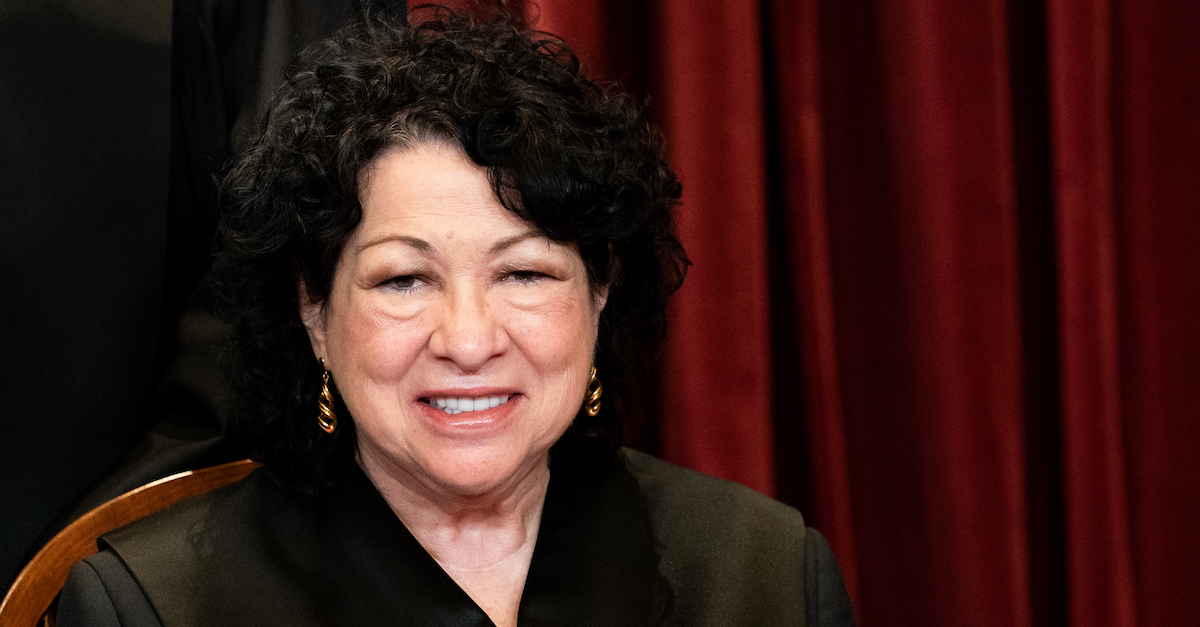
WASHINGTON, DC – APRIL 23: Associate Justice Sonia Sotomayor sits during a group photo of the Justices at the Supreme Court in Washington, DC on April 23, 2021.
Supreme Court Justice Sonia Sotomayor dissented from an order denying certiorari on Monday in a qualified immunity case where a police officer killed a man who appeared to be threatening suicide.
“On May 24, 2011, Willie Gibbons was shot and killed by a police officer,” the justice’s dissent begins. “It is undisputed that the officer who shot him knew that Gibbons suffered from a mental illness and that he was holding a gun to his own temple. It is also undisputed that Gibbons never threatened the officer in any way and that the encounter was over within seconds, leaving Gibbons fatally wounded.”
Sotomayor notes, however, that the “remaining facts” are “disputed.”
In the case stylized as Arlane James v. Noah Bartelt, the dead man’s mother and surviving siblings sued the New Jersey State Police, Trooper Noah Bartelt and others for damages. Gibbons’s family won a limited victory at the district court level–with the judge granting qualified immunity to all of the named defendants except for Bartelt.
The Garden State trooper had the district court reversed on appeal and succeeded in the the Third Circuit Court of Appeals on two separate occasions. First, Bartelt convinced a three-judge panel led by (Donald Trump-appointed) Circuit Judge David J. Porter in April 2021.
The Gibbons family appealed for a rehearing before the entire appellate court but, again, Bartelt came away victorious four months later–in another Porter-authored opinion. The second time, the majority was taken to task by way of a vociferous, five-judge dissent penned by (Bill Clinton-appointed) Circuit Judge Theodore McKee.
In dissent, McKee complained that the denial and earlier victory for the state trooper “squarely contradicts controlling precedent” in a case with “circumstances substantively identical to those here.”
That case, Bennett v. Murphy, which should have controlled the Gibbons-Bartelt controversy, in McKee’s opinion, stands for the proposition that “[if the victim] had stopped advancing and did not pose a threat to anyone but himself, the force used against him, i.e. deadly force, was objectively excessive” and therefore unreasonable.
“For the reasons ably set forth by Judge McKee in his dissent from denial of en banc review, the Third Circuit erred by improperly resolving factual disputes in respondent’s favor and by overlooking binding precedent to conclude that he did not violate a clearly established constitutional right,” Sotomayor wrote in her terse dissent, using a relevant term of art in qualified immunity cases.
In qualified immunity cases, plaintiffs attempting to sue police officers and other government employees typically have a hard time showing that an officer’s alleged bad behavior runs afoul of what the Supreme Court has termed “a clearly established constitutional right.” This means the person being sued would have understood what they were doing was unconstitutional because the law was clear at the time.
In effect, however, this is a high bar to pass. Because the phrase is another way of saying a plaintiff has to show an officer’s alleged bad behavior must line up with the facts in a prior decision from the same jurisdiction where another officer’s alleged misconduct has previously been judged to be unconstitutional.
Here, Sotomayor relies on the voluminous dissent by McKee, which repeatedly, over the course of dozens of pages, likens the facts in the Gibbons case to Third Circuit precedent viz. Bennett.
McKee’s dissent is encapsulated by the following summary:
The victim here posed no greater threat than the victim in Bennett. Yet, now we hold that Trooper Noah Bartelt is entitled to qualified immunity as a matter of law. We reach that conclusion even though Willie Gibbons, the victim here, was pointing a gun at his own head when fatally shot by Bartelt. There has been no intervening change in the law in the eighteen years since we decided Bennett, and our Opinion here does not suggest otherwise.
“I add only that qualified immunity properly shields police officers from liability when they act reasonably to protect themselves and the public,” Sotomayor wrote. “It does not protect an officer who inflicts deadly force on a person who is only a threat to himself. That proposition is so ‘apparent’ that any reasonable officer is surely ‘on notice’ that such a use of force is unlawful.”
[image via Erin Schaff-Pool/Getty Images]